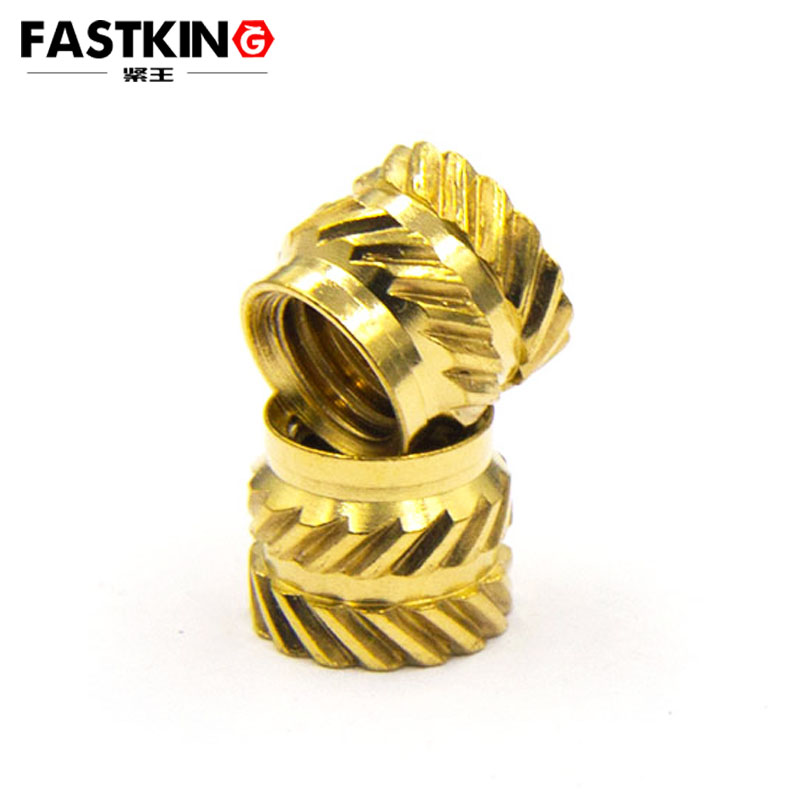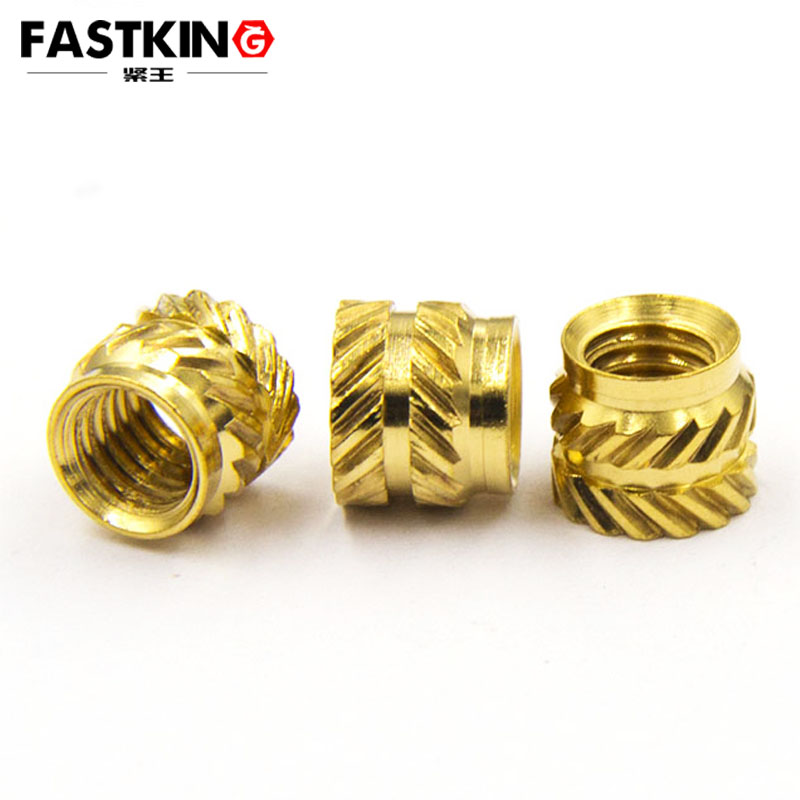- ZHUHAI JIALI HARDWARE CO.,LTD.
- +86-756-8586520
copper insert hot melt clay eight nut knurled brass nut
- Product description:In the assembly of products such as plastic casings, household appliance components, and automotive interiors, plastic materials inherently have low strength, and direct tapping is prone to thread str
I. Product Definition: The "Metal Fastening Core" for Plastic Parts
Both double-helical hot-melt nuts and injection-molded copper nuts are made of high-purity copper (e.g., H62 brass) as the base material, with their core function being to provide stable internal threaded connection points for plastic parts. The core difference between the two lies in their bonding process with plastic parts:
- Double-helical hot-melt nuts: The outer surface of the nut is processed with two helical threads (spiral patterns) in opposite directions. Using hot-melt equipment, the nut is heated to a specific temperature (usually 180-220℃) and pressed into the pre-drilled hole of the plastic part. The plastic softens when heated, engages with the helical threads, and forms a tight bond after cooling. The helical thread structure can effectively prevent the nut from rotating or falling off.
- Injection-molded copper nuts: During the injection molding process of the plastic part, the nut is pre-placed in the mold cavity. The molten plastic wraps around the nut and fills the patterns on its surface (such as straight patterns, mesh patterns, or helical patterns). After cooling, the nut and the plastic part become an integrated unit, eliminating the need for subsequent heating and pressing. This type is suitable for mass production scenarios.
Compared with ordinary straight-threaded nuts, the core advantage of the double-helical design is "bidirectional anti-loosening": a single helical thread can only resist torque in one direction, while double-helical threads can resist forces in both clockwise and counterclockwise directions. In scenarios such as car jolts and household appliance vibrations, the probability of nut loosening is significantly reduced.
II. Structural Features: "Anti-Loosening Design" Adapted to Plastic
The structural design of both types of nuts focuses on "tight bonding with plastic" and "anti-loosening and anti-slip", with notable detailed highlights:
-
Double-helical hot-melt nuts: The pitch of the double helical threads on the outer surface is usually 0.8-1.5mm, and the thread depth is 0.2-0.5mm. This design not only ensures sufficient engagement area with plastic but also prevents the plastic part from cracking due to excessively deep threads. The two ends of the nut are provided with guiding chamfers (angle 30°-45°), which allow accurate alignment with the pre-drilled hole during pressing to avoid deviation. Some models also feature anti-rotation grooves inside to further enhance the anti-loosening effect.

- Injection-molded copper nuts: In addition to common straight patterns and mesh patterns, they can also adopt a double-helical structure. The ratio of their length to diameter (usually 1:1.2-1:2) is optimized to ensure that the plastic can fully wrap the nut during injection molding, avoiding air bubbles or gaps. The precision of the internal thread of the nut is mostly Grade 6H, which is compatible with bolts of corresponding specifications and ensures smooth screwing without jamming, thus guaranteeing assembly efficiency.
Furthermore, both types of nuts undergo surface treatment: galvanization (colored zinc, white zinc) can improve corrosion resistance, making them suitable for humid environments; passivation treatment can enhance surface hardness, preventing scratches on the surface during pressing or injection molding and extending the service life.
III. Working Principle: The "Tight Bonding Technology" of Hot-Melt and Injection Molding
1. Double-Helical Hot-Melt Nuts: Heating Engagement, Cooling Fixation
Its installation process consists of three steps: First, a pre-drilled hole is made in the plastic part according to the nut specification (the hole diameter is 0.1-0.3mm smaller than the nut diameter to ensure an interference fit). Then, the heating head of the hot-melt machine heats the nut to the set temperature, so that the copper material on the nut surface conducts heat to the area around the pre-drilled hole of the plastic, and the plastic softens into a semi-molten state. Finally, the heating head applies axial pressure to press the nut into the pre-drilled hole. The double-helical threads embed into the softened plastic, and after maintaining the pressure for 5-10 seconds for cooling, the plastic solidifies and shrinks, tightly engaging with the double-helical threads to form a non-detachable fastening structure.
The advantage of this process is "fast and efficient"—the pressing time for a single nut is only 10-20 seconds, making it suitable for small-batch or flexible production lines. Moreover, the bidirectional anti-loosening feature of the double-helical threads can resist nut loosening caused by long-term vibration.

2. Injection-Molded Copper Nuts: Pre-Embedded in Mold, Integral Molding
The injection molding process is more suitable for mass production: Step 1, according to the product design, the nut is fixed at the designated position in the plastic mold cavity (fixed by positioning pins or magnets to prevent displacement during injection molding). Step 2, the injection molding machine injects molten plastic into the mold cavity. The molten plastic wraps around the surface patterns of the nut and fills the gaps. Step 3, after the mold is cooled, it is opened, and the plastic part and the nut become an integrated unit. The surface patterns of the nut form a mechanical engagement with the plastic, which can be directly used without subsequent processing.
The core advantage of this process is "high connection strength"—the bonding area between the plastic and the nut is larger, and there is no damage to the plastic part caused by the heating process, making it suitable for products with high precision requirements (such as mobile phone middle frames and laptop casings).
IV. Application Scenarios: Covering Plastic Fastening Needs in Multiple Fields
With their compatibility with plastic parts, both types of nuts play an important role in multiple fields:
- Electronics and household appliance field: For fixing mobile phone charger casings and washing machine control panels, double-helical hot-melt nuts of M2-M4 specifications are commonly used. The plastic casing has low strength, and the nut provides a stable threaded point for connecting internal circuit boards with bolts. The double-helical threads can effectively prevent loosening during the slight vibration of household appliances, avoiding noise caused by loose components.
- Automotive industry: Injection-molded copper nuts are mostly used for automotive interior panels (such as instrument panels and door panels). They are pre-embedded during injection molding, and in subsequent assembly, they are connected to metal brackets with bolts. The double-helical design can resist the jolting vibration of the car during driving, ensuring that the interior panels do not loosen for a long time. Additionally, the thermal conductivity of copper can assist in heat dissipation, protecting the plastic interior parts.
- Home furnishing and toy field: For plastic furniture connectors and children's toy casings, small-specification (M1.6-M3) double-helical hot-melt nuts are commonly used. The hot-melt process does not require molds, making it suitable for customized furniture production. The anti-loosening feature of the double-helical threads can prevent components from falling off when children play with the toys, improving toy safety.
V. Product Advantages: Why They Become the First Choice for Plastic Fastening
Compared with other plastic fastening solutions (such as self-tapping screws and plastic expansion nuts), double-helical hot-melt nuts and injection-molded copper nuts have significant advantages:
First, high connection strength: The tensile strength of copper material is ≥300MPa, which is much higher than that of plastic. It can withstand greater axial tension and torque, avoiding damage to the plastic part caused by direct force. Second, excellent anti-loosening effect: The bidirectional engagement of the double-helical threads provides better anti-loosening performance than single-helical or straight threads, making it suitable for vibration scenarios. Third, strong weather resistance: Copper material is corrosion-resistant, and after surface treatment, it can adapt to humid and high-temperature environments (such as plastic parts around the car engine compartment) with a long service life. Fourth, convenient assembly: There is no need to tap threads on the plastic part, which reduces processing procedures and lowers production costs.
As the "reliable connectors" for plastic part fastening, double-helical hot-melt nuts and injection-molded copper nuts solve the pain points of plastic material fastening with their characteristics of "high strength, anti-loosening, and compatibility with plastic". Whether for small-batch hot-melt assembly or large-batch injection production, they can provide stable and reliable connection solutions, becoming indispensable key components in industrial manufacturing.

